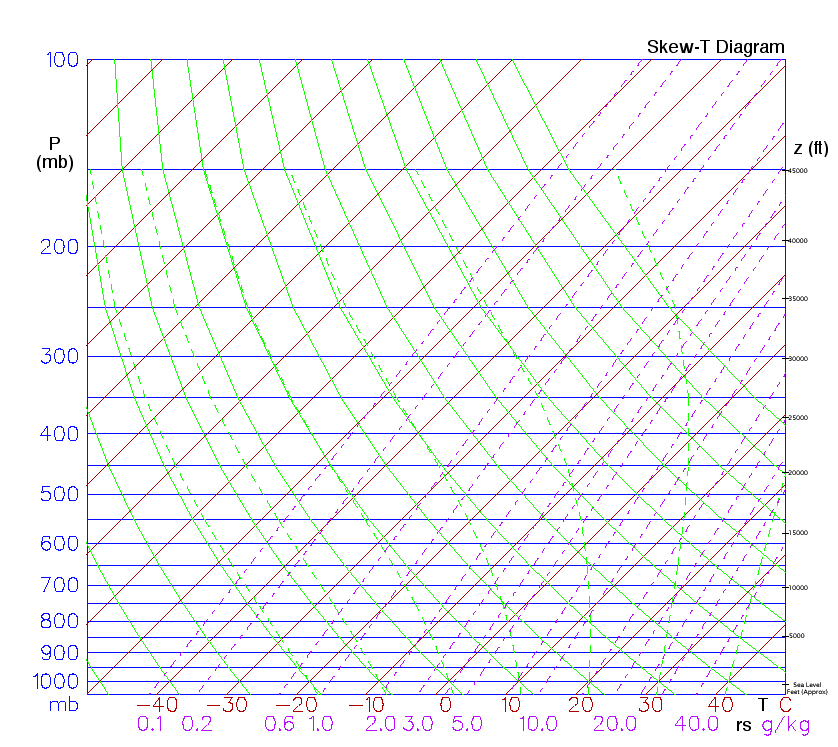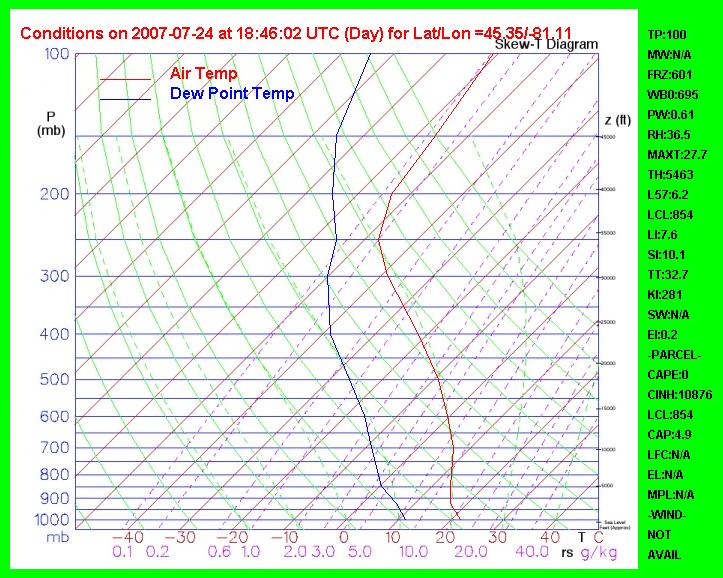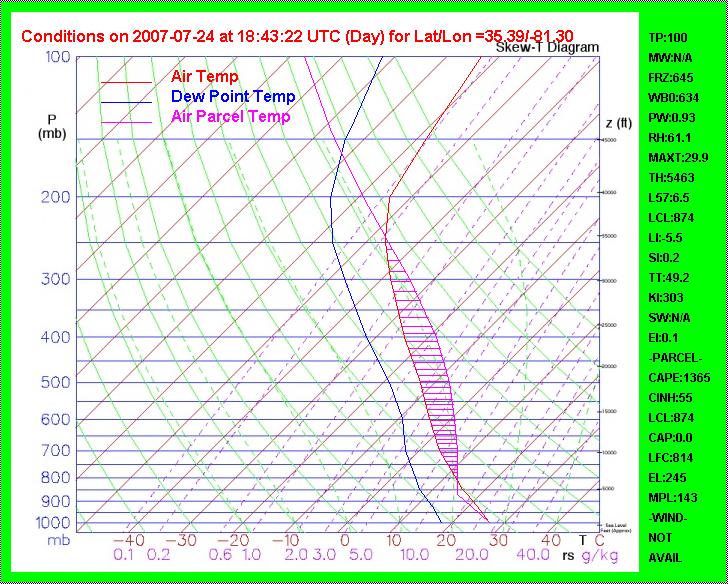Introduction to the SkewT Diagram
The SkewT diagram, more formally as the SkewT-LogP diagram,
is a very useful meteorological thermodynamic chart on which pressure,
density, temperature, and water vapor are plotted for a point on the Earth surface up
through the atmosphere. Every SkewT diagram consists of both a static set of
atmospheric calculations, which apply equally to all locations, and a dynamic
set of air temperature and dew point temperature calculations obtained by
direct measurement of the atmosphere. This set of observations is typically obtained
by the lofting of a small radiosonde instrument package, commonly referred to as a
weather balloon, from many airports and meteorological stations around the globe every day.
NASA's Atmospheric Infrared Sounder (AIRS), with the help of
its sister instrument, the Advanced Microwave Sounding Unit A (AMSU-A), have been
deriving these same temperature and pressure profiles, remotely from space, since
shortly after their May 4, 2002 launch aboard NASA's Earth-orbiting Aqua
satellite.
The following sections provide a brief introduction to meteorology as it relates to the general characteristics of the Earth's atmosphere. No formal mathematics or science training is assumed or required. After reading this material you will have a good basic understanding of the role of moisture in the atmosphere and gain a new appreciation for all those puffy white or ominous gray clouds you see when there is a change in the weather.
SkewT Diagram Layout
First, let us discuss the static part of a SkewT diagram, which is the background
upon which any actual measurements are compared. In the figure shown below, note along the left vertical
axis that air pressure is plotted on a descending scale, with the highest
pressure near sea level (defined at 1013 millibars) or low topography over land at the bottom and 100 millibars at the top. This vertical axis
uses a Base 10 logarithmic scale to
accommodate the rapid drop in pressure with altitude. Also, the Earth's atmopsheric pressure decreases in approximately a linear fashion with the logarithm of the increase of altitude, such that the pressure conditions at altitudes of 100, 1000, and 10,000 meters would also be equally spaced apart on a vertical graph axis. Some SkewT diagrams also include an altitude or "Z" axis on the right vertical axis of the figure (also shown here)
where the values (in feet) are based on a "standard atmosphere" model.
For reference, commercial aircraft operate near an altitude (pressure)
of about 250 millibars. Along the horizontal are two sets of numbers. The first set of numbers, shown here in red,
mark the starting point of straight dark red lines running at a 45-degree angle from lower left to
upper right. These parallel lines of constant temperature (called "isotherms") have been
titled or "skewed" 45 degrees in a clockwise direction to allow the plotting of very low
air temperatures at higher altitudes. The purple numbers are the starting point for dashed purple
lines that are vertical but somewhat curved. These represents the temperature as a function of altitude (pressure)
for the maximum amount of water (saturation) that can be absorbed within a parcel of otherwise dry air. For example, at
sea level (pressure = 1013 mb) at 25 degrees C (77 degrees F), up to 20.0 grams of water can be retained by one kilogram of air.
At 700 mb, this same water content can occur at an air temperature of only 20 degrees C (68 degrees F).
The curved and solid green lines identify the changes in temperature as a function of pressure (altitude) of a parcel of air that rises or falls based on its temperature relative to the surrounding atmosphere. An air parcel that is warmer than the surrounding air will rise and a relatively cooler parcel of air will sink. Another interesting fact and a major part of our weather is that an air parcel that is saturated with water (per the purple lines) will retain heat within the water droplets and release it very slowly. For example, if you hold your hand in the steam coming out of a teapot of boiling water, it will get burned as soon as the water vapor condenses to liquid on your skin. When water vapor condenses as droplets, it releases large amounts of heat, far more than would be carried by dry air at the boiling temperature of water. A similar process warms the atmosphere as water vapor condenses into cloud droplets at saturation. In the SkewT diagram, the solid green lines represent the cooling rate versus altitude for air that is NOT at the saturation state. These so-called "dry adiabat" parcels will cool off at a rate that varies only slightly based on an initial conditions (e.g., with the sea level or low topography over land as a starting point shown in the figure). On the other hand, the dashed green lines that characterize a saturated or "moist adiabat" parcel are similar to the dry adiabat only at very low initial temperatures. Otherwise, the cooling rate is much slower at higher initial temperature because more water (and more latent heat) can be retained at the initial higher temperatures. The saturation water content increases exponentially with temperature (i.e., warm air in the tropics can hold much more water content than cold air near the poles).
Sample SkewT Diagram

Atmospheric
Soundings
The "actual observations" or atmospheric soundings on a SkewT diagram, shown
in the following figure, are indicated as an air temperature profile (solid thick red line) and the dew point
temperature (solid thick blue) line, each plotted against pressure and temperature.
One important feature of the SkewT diagram is that where these
lines come close together (within 10 degrees Celsius or so) there will be clouds, whereas widely separated lines
indicate fair weather and good visibility for aircraft pilots (See this article
When these atmospheric profiles (soundings) are obtained from a
radiosonde,
measurements of air temperature and relative humidity are collected occur over a few hours as the instrument package rises up and drifts
downwind of the release site. Therefore, although the data are accurate, they
represent the path traversed by the radiosonde, which is generally not a
straight vertical column of air. The unique benefit of a radiosonde, therefore, is
the valuable information on wind speed and direction which it can provide, which AIRS cannot measure from space.
On the other hand, AIRS+AMSU-A together survey an east-west swath of thirty adjacent
vertical columns of air (also called footprints) every eight seconds.
These data are therefore associated with a precise time and location. In addition, thanks to a data-sharing
arrangement with the National Oceanic and Atmospheric Administration (NOAA) and the NASA Goddard Space Flight Center,
data from scanning passes as recently as 4 hours after an Aqua/AIRS overpass are now available to produce
Skew T diagrams for any location on the
globe.
As will be discussed in the next section, a great deal of valuable information
about an atmospheric profile can be obtained from a SkewT diagram simply by
reading the intersections of various lines on the chart. In addition, many
SkewT diagrams also include the trajectory of a theoretical parcel of air that
starts at the same position as the measured temperature profile but then rises
under very special thermodynamic assumptions which may different than the actual atmospheric conditions.
Thermodynamic Background of the SkewT Diagram
In this section you will learn how thunderstorms are created!
Whenever an air parcel is
less dense than the surrounding air it will naturally rise up through the
atmosphere. The surrounding air may or may not cool off at the same rate, due
to factors such as local wind patterns. It is therefore helpful to visualize a
theoretical parcel of air under very specialized assumptions and then compare
it during its ascent through the actual atmospheric conditions as measured by instruments such as a
radiosonde or AIRS.
The notion of a rising air parcel is that it starts out unsaturated (dry) and rises up naturally to the point where the surrounding relatively cooler air temperature causes the water vapor to condense into water droplets, converting the air parcel into a saturated air mass. This lifting mechanism is natural convection but sometimes a warm air parcel on the ground gets pushed up the side of a mountain by the wind or simply lifted up by a coming together of winds from various directions (also called a mass convergence). This is known as an adiabatic process because no extra heat energy is being added to the parcel as it rises (i.e., it cools down simply because the surrounding air is cooler). This transition from a dry to a moist adiabat is a straightforward calculation based on the initial surface temperature and water mixing ratio and is referred to (in terms of pressure and altitude) as the "Lifting Condensation Level" (LCL) - one of the many parameters along the right margin of a SkewT diagram. On the SkewT diagram, then we can state that the air parcel follows a (solid green) dry adiabat line up to the calculated LCL and then switches to the (dashed green) moist adiabat line. It will only continue to rise, however, if it remains warmer and more buoyant than its surroundings. If you in an airplane and observe a very low, flat cloud deck below, the LCL s fairly close to the ground. The air below the cloud deck is generally warm and moist and the air above the cloud deck is clear and cool.
First, let's consider an example of very stable atmospheric conditions
The SkewT diagram shown above indicates calm weather conditions and there is no obvious third line in the figure to describe the trajectory of a rising air parcel. There are only lines for the air temperature (red) and dew point (blue) temperature profiles. The reason for this is that a rising air parcel will first follow the air temperature profile, for a very short distance, along a dry adiabat (solid green) line that starts out near the surface at around 22 deg C up and reaches the Lifting Condensation Level (LCL) at 854 millibars, or about 5,000 ft. At the LCL, the air parcel becomes saturated and would normally start to follow a moist adiabat (dashed green) line. However, we can also see that the air temperature curve (i.e., the atmosphere conditions surrounding the air parcel) bends to the right as altitude increases, suggesting constant or slightly increasing temperatures. In other words, once an air parcel reaches the LCL, even though it is saturated, it will immediately encounter surrounding air that is warmer. Since a relatively cooler air parcel sinks, the rising air parcel can rise no further, which is the reason an air parcel trajectory is not prominent in this figure. Overall, we can see in this figure a wide separation between the dew point (blue) and the air (red) temperature lines at the LCL, which suggests that there are no low-level clouds. There is moisture in the air because we see indications of clouds at 250 millibars, but these are probably thin cirrus clouds blown in from a separate, distant weather system. This is also an example of a condition known as a temperature inversion, where warm air sits on top of cooler ground air, which can occur in the region of this SkewT diagram (the eastern Great Lakes in midsummer 2007).
Another useful SkewT diagram indicator is called the Lifting Index (LI), a measure of the atmospheric stability. A negative Lifted Index value indicates unstable storm-like conditions. However, the atmosphere profile in this SkewT diagram has an LI of +7.6, which indicates extremely stable conditions. The SkewT diagram tool presented at this web site uses Lifted Index as quick reference to the stability of various atmosphere profiles among the many adjacent observations that a user might wish to examine with this tool.
Sample SkewT Diagram for Calm, Clear
Weather

Now, let's consider an example of very unstable atmospheric conditions
The next figure illustrates what happens when a rising air parcel
become saturated at the LCL but then encounters relatively cooler surrounding air. First, note that this SkewT diagram
has three lines to illustrate the non-stable atmospheric conditions. The red line, as before, indicates
the profile of air temperature which shows a fairly consistent decrease
in temperature at all altitudes below 250 millibars. The blue line for dew point
temperature is parallel and generally within 10 degrees Celsius of the air temperature line, which
indicates a very deep layer of clouds. The third line, shown in magenta, tracks the hypothetical air parcel
that starts out near the surface (1000 millibars) at an initial temperature of about 27 degrees C,
or about 81 deg F. Note that it rises along a dry adiabat (solid green) line and then becomes a moist adiabat (dashed green) line at the LCL (874 millibars). However,
there is a point (at 814 millibars) where the air parcel temperature (magenta line) exceeds the surrounding air temperature (red line).
This is known as the "Level of Free Convection" (LFC) and from
this point all the way up to where the air parcel has cooled down to match the surrounding air
again at the "Equilibrium Level" (EL) at 245 millibars, is the region called the "Zone of Free Convection".
A measure of this instability is found in the
"Convective Available Potential Energy" (CAPE), also shown on the right margin as 1365.
The Lifted Index for this SkewT diagram is -5.5, a very large negative number usually associated with
powerful thunderstorms. The "Maximum Parcel Level" (MPL) reflects the altitude at which the full
amount of CAPE has been finally balanced out by the air parcel's rise, after
which it stabilizies in altitude and gradually sinks as it cools. In general, the SkewT diagram will have a separate trajectory line for the air parcel only whene there is postive CAPE value.
As such if we examine the date, time and location for this SkewT plot, we find that it
was taken at 2:43 PM on July 24, 2007 in northern Georgia just east of
the Appalachian Mountains. Most meteorologists would not be surprised to see
thunderstorms at that location on a warm midsummer afternoon.
Sample SkewT Diagram for Severe
Weather

Additional
References
We hope that this discussion has helped introduce you to some of the fascinating information that can be gleaned from a SkewT diagram.
A comprehensive description of
the standard SkewT parameters can be found at the following
URL: http:www.theweatherprediction.com/thermo/parameters
The following web site provides additional information
about the SkewT diagram, including resources
on near-real-time SkewT measurements collected at many local airports.
http://www.skew-t.com/skew-t.htm